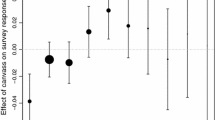Abstract
This paper examines two influences on an individual's decision to vote or not to vote on election day: the partisan door-to-door canvass and the social setting. Because that decision is important to political parties and candidates, they do what they can to influence the individual's decision, with the campaign canvass being one of the most important and effective methods. However, the decision also takes place in a social setting and is influenced by others in that setting. This paper examines these two influences on the individual and finds how they interact and that one conditions the other; the paper argues that the conditioning occurs because the social setting and canvass share a similarity in mechanism in the way that each exerts influence on the individual.
Similar content being viewed by others
References
Blydenburgh, John C. (1971). A controlled experiment to measure the effects of personal contact campaigning.American Journal of Political Science 15: 365–381.
Bochel, J., and D. Denver. (1971). Canvassing, turnout, and party support: An experiment.British Journal of Political Science 1: 257–270.
Brown, Thad A. (1978). Some Consequences of Internal Migration on Individual Partisan Attitudes. Working Paper. Los Angeles, CA: University of California.
Cutright, Phillips. (1963). Measuring the impact of local party activity on the general election vote.Public Opinion Quarterly 27: 372–386.
Cutright, Phillips, and Peter Rossi. (1958). Grass roots politicians and the vote.American Sociological Review 23: 171–197.
Downs, Anthony. (1957).An Economic Theory of Democracy. New York: Harper and Row.
Eulau, Heinz. (1980). Editor's note.Political Behavior 2: 215–218.
Ferejohn, John, and Morris Fiorina. (1974). The paradox of not voting: A decision theoretic analysis.American Political Science Review 68: 525–536.
Giles, Michael W., and M. W. Dantico. (1982). Political participation and the neighborhood social context revisited.American Journal of Political Science 26: 144–156.
Gosnell, Harold. (1927).Getting Out the Vote: An Experiment in the Stimulation of Voting. Chicago, IL: University of Chicago Press.
Gosnell, Harold. (1950). Does campaigning make a difference?Public Opinion Quarterly 14: 413–418.
Huckfeldt, R. Robert. (1977). Political Behavior and the Social Context of Urban Neighborhoods. Dissertation. St. Louis, MO: Department of Political Science, Washington University.
Huckfeldt, R. Robert. (1979). Political participation and the neighborhood social context.American Journal of Political Science 23: 579–592.
Katz, Daniel, and Samuel Eldersveld. (1961). The impact of party activity upon the electorate,Public Opinion Quarterly 25: 1–24.
Kramer, Gerald. (1970). The effects of precinet level canvassing on voter behavior.Public Opinion Quarterly 34: 560–572.
Miller, Warren E. (1956). One-party politics and the voter.American Political Science Review 50: 707–725.
Rosenstone, Steven, and Raymond Wolfinger. (1978). The effect of registration laws on voter turnout.American Political Science Review 26: 25–45.
Verba, Sidney, and Norman Nie. (1972).Participation in America. New York: Harper and Row.
Wolfinger, Raymond, and Steven Rosenstone. (1980).Who Votes? New Haven, CT: Yale University Press.
Author information
Authors and Affiliations
Rights and permissions
About this article
Cite this article
Krassa, M.A. Context and the canvass: The mechanisms of interaction. Polit Behav 10, 233–246 (1988). https://doi.org/10.1007/BF00990553
Issue Date:
DOI: https://doi.org/10.1007/BF00990553




